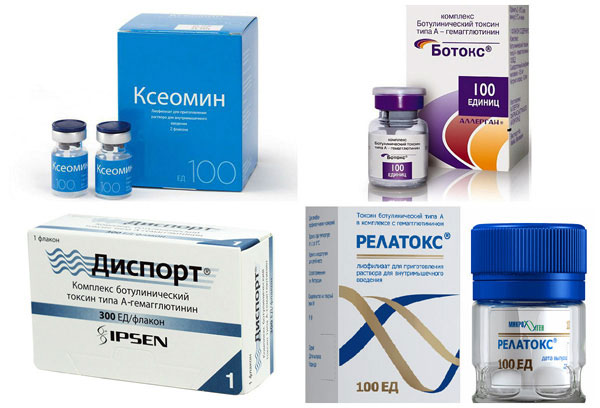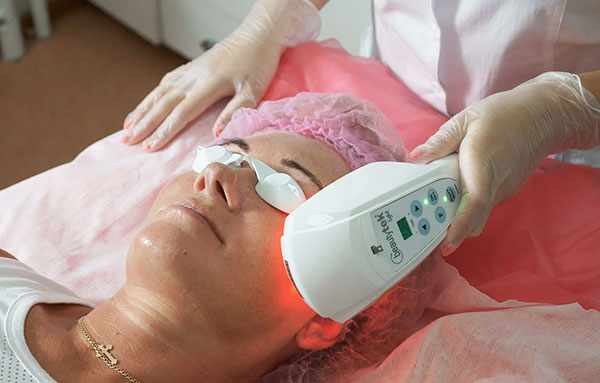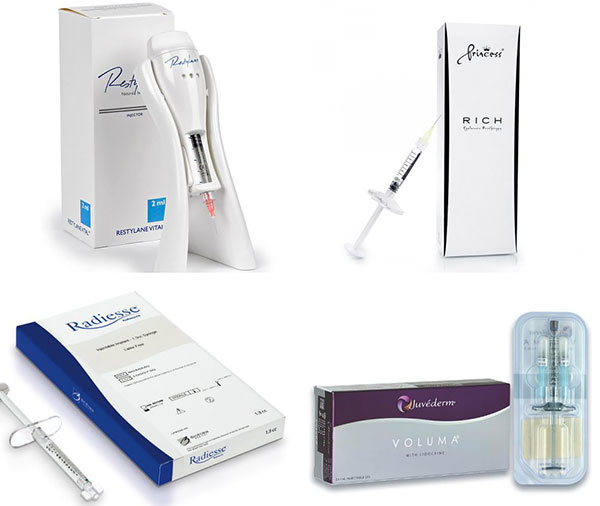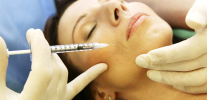
Botulinum therapy and biorevitalization of the skin are today one of the most common anti-aging cosmetic procedures. Both of them are carried out most often to solve problems associated with aging, weakening and thinning of the skin, resulting in the appearance of wrinkles, spots, dents and other defects that are very noticeable and spoil the appearance. Therefore, it is not surprising that there is a widespread belief that Botox injections and biorevitalization are, to some extent, interchangeable procedures, which means that one of them in one case or another may be better than another.
In fact, botulinum therapy and biorevitalization are by no means interchangeable procedures. Despite the seemingly unified scope of their application, the objectives of their implementation are different. In those situations where Botox will help, biorevitalization will be ineffective. Conversely, the result that is provided by biorevitalization cannot be obtained using botulinum toxin preparations.
This is relevant, by the way, for different methods of biorevitalization. Both the classical version of this procedure, which consists in subcutaneous injections of hyaluronic acid, and modern methods - from injections of cosmetic shakes (actually mesotherapy) to laser biorevitalization - cannot be replaced by Botox, nor can they replace it themselves.

Injections of hyaluronic acid remain the classic version of biorevitalization.
In other words, situations almost never arise in which one could choose between botulinum therapy and biorevitalization and decide which of these procedures is better. To solve a specific cosmetological problem, either Botox or the introduction of biorevitalizants is required.
Sometimes there may be a need for both procedures. This happens when the patient has a whole range of cosmetic defects, one part of which is eliminated only by Botox, and the other only by biorevitalization. In such situations, both procedures can be carried out, but not simultaneously, but in a certain sequence.
In what cases is it necessary to use Botox, and in which - biorevitalization? What are the results achieved with these procedures? How do they finally fit together? Let's find out these nuances.
Botox uses
The main cosmetological goal of using Botox is the removal of deep facial wrinkles. Most often, with the help of this tool they eliminate skin creases between the eyebrows (the so-called eyebrow wrinkle, or “eyebrow”), on the forehead, along the edges of the eyes (“crow's feet”) and under them, as well as the folds that form on the nose when expressing indignation and aggression (the so-called rabbit wrinkles).
After proper botulinum therapy, these wrinkles disappear completely for a period of 4 to 9 months, and sometimes even for a longer time.
Botulinotherapy is also carried out for other purposes, among which:
- Correction of the asymmetry of the position of the eyelids and eyebrows;
- Lip asymmetry correction;
- An increase in the palpebral fissure when opening the eyes;
- Elimination of gingival smile;

With the help of botulinum toxin, you can correct your gingival smile.
- Strengthening the effect of biorevitalization and mesotherapy;
- Treatment of various spasms of the muscles of the face;
- Strabismus treatment;
- Elimination of wrinkles on the neck and décolleté;
- Correction of the relief of muscles, contour plastics of the face and various parts of the body;
- Correction of the appearance of scars and scars in places of active muscle contraction.
In all cases, except for correcting the appearance of scars, the effect of using Botox is temporary. It gradually disappears after a few months, and to resume it, the procedure must be repeated.
At the same time, Botox does not affect the condition and appearance of the skin, with its help it is impossible to increase its elasticity, to achieve the effect of fullness, to eliminate age spots. Botulinum therapy also does not allow to eliminate small static wrinkles caused by thinning of the skin and sagging. All these are precisely the tasks of biorevitalization.
What are the results after biorevitalization?
The goals of biorevitalization are to restore and maintain the normal structure of the skin. After a correctly performed procedure or a course of procedures, the skin becomes more elastic, dense and clean, capillaries cease to be visible on it. Due to the increase in its turgor and elasticity, small static wrinkles are smoothed out (including those caused by aging and weakening of the skin), age spots may disappear or become less noticeable.
Previously, only injections of hyaluronic acid preparations were used to obtain this effect. Today, many methods are used for biorevitalization of the skin, often in some ways similar to classical injections, but sometimes - radically different from them.
For example, today biorevitalization can be called such procedures:
- Injections of complex preparations, which in addition to hyaluronic acid also include vitamins, amino acids and various other components that affect the condition of the skin;
- Non-injection injection of biorevitalizants into the skin using the methods of iontophoresis, laser phoresis, magnetophoresis, cryogenic therapy, ultraphonophoresis and others.

In modern cosmetology, all types of non-injection procedures for the administration of biorevitalizants are also called biorevitalization.
The task of all these methods is to saturate the skin with hyaluronic acid and stimulate the activity and reproduction of fibroblasts. Hyaluronic acid provides skin turgor and maintains (or restores) its normal structure, primarily a three-dimensional spatial matrix of cells and intercellular substance. Fibroblasts also produce collagen and elastin proteins, which provide normal skin elasticity, its elasticity, the ability to withstand loads and recover after wrinkling.
If you want to know more about non-injection methods of biorevitalization, see the video below:
Simply put, all biorevitalization methods provide similar effects:
- Partial elimination of static and gravitational wrinkles;
- Removing dents on the skin;
- The elimination of the capillary network;
- Elimination of sagging skin;
- Reducing the severity of age spots;
- Increasing firmness and elasticity of the skin, its "splendor" and fullness.
On a note
It is important to understand that Botox eliminates dynamic wrinkles more efficiently, faster and usually more fully than biorevitalization removes static ones. With equal professionalism of the cosmetologist and the quality of the procedures, the wrinkles after Botox are completely gone, and after biorevitalization, they often only decrease in depth and severity.

Botulinum therapy eliminates dynamic wrinkles almost completely.
The choice of one of several biorevitalization methods is carried out in order to increase the safety of procedures or the speed of obtaining the desired effect within the budget acceptable to the client.
On a note
It may seem that biorevitalization and mesotherapy are one and the same. Indeed, a strict line between these terms is difficult to draw because of their rather free interpretation and operation. However, mesotherapy is usually understood as any injection technique, often not related to skin regeneration - for example, carried out to combat cellulite or to treat hair. In fact, biorevitalization is a special case of mesotherapy.
Can Botox be replaced with biorevitalization?
As you can see, Botox cannot be replaced with biorevitalization - these are completely different procedures that differ from each other both in terms of the principle of action of the drugs used and in the effect obtained.
In cases where the patient has deep dynamic wrinkles, and even more so the asymmetry of the eyelids, lips or eyebrows, the use of botulinum toxin preparations is required. No cocktails with hyaluronic acid will help to get rid of these defects, since they are eliminated by correction of the force of muscle contraction provided by Botox or its analogues.
On the other hand, those problems that are solved using biorevitalization methods cannot be eliminated by Botox either. The physiological effect provided by botulinum toxin is a temporary denervation of muscles, due to which their relaxation and blocking of contractions are achieved. If cosmetic problems are related to the condition of the skin, such muscle relaxation does not help to eliminate them.
Therefore, it makes no sense to try to choose the best between these two methods. Which one to apply is determined by the cosmetologist depending on the specific indications and the desired result for which the client turned to him.

Only a cosmetologist can determine exactly what type of procedure a client needs to resolve a particular cosmetic problem.
We can speak about the choice only if the patient has indications for both Botox injections and biorevitalization. In this case, the patient himself or together with the doctor decides what specific defects he wants to eliminate, and, therefore, what procedures will be performed for him.
For example, if the patient believes that his skin condition is still normal, but facial wrinkles attract attention too much, it is advisable to conduct botulinum therapy. Or, on the contrary, if the patient's wrinkles are not confused, but you want to eliminate thinning and sagging skin, biorevitalization is chosen.
But in most such cases, both patients and cosmetologists prefer to combine botulinum therapy with biorevitalization in order to get rid of the maximum number of defects. How safe is this combination of methods and how is it implemented in practice?
When is botulinum therapy and biorevitalization advisable to combine and how to do it
The situation when botulinum therapy and biorevitalization must be combined is typical for people over 40-45 years old. Their cosmetic problems accumulate like an avalanche and provoke each other. Due to skin aging and structural damage, fine wrinkles appear, cell nutrition worsens, fibroblast proliferation slows down, due to which the amount of collagen and elastin decreases, and endogenous hyaluronic acid is “washed out”. The skin becomes less firm and supple.
Due to the decrease in skin elasticity, wrinkles arising from mimic muscle contractions are not completely smoothed out after the expression of emotion is completed. Quickly enough, a fold appears in this place, gradually deepening and becoming noticeable even when the skin and muscles are at rest. At the crease, the dermis layer is the thinnest, the number of fibroblasts and hyaluronic acid in it is minimal. This accelerates degradation processes.
In these cases, it is advisable to carry out complex skin care, in which first Botox is used to eliminate large wrinkles, and then the face skin in problem areas is “serviced” using biorevitalization preparations. Moreover, subject to all the necessary rules, these methods are completely compatible.

Combining botulinum therapy and biorevitalization is advisable, as a rule, to patients after 40 years.
It is in this sequence that the procedures are carried out - first botulinum therapy, then, after the period of rehabilitation - biorevitalization.This order is necessary because when conducting only biorevitalization in places of deep creases, the drug will not be distributed as evenly as in the areas between them. This will lead to heterogeneity of its effect on the skin, as a result of which the desired effect of biorevitalization will not be achieved.
If biorevitalization is carried out after botulinum therapy, then the drug, distributed in the skin, on which there are no wrinkles, evenly fills the entire intercellular space and has a more “even” effect.
Moreover, the sessions of these methods cannot be carried out on the same day, especially at the same time. There are several reasons for this:
- After Botox injections for at least 3-4 days, it is necessary to refrain from any cosmetic procedures in order to avoid the manifestation of side effects of botulinum therapy. Biorevitalization requires a mandatory preliminary session of microdermabrasion, which has a serious effect on the skin and can affect the result of botulinum therapy. Biorevitalization itself acts even stronger, and therefore a significant interval is required between it and injections of botulinum toxin preparations;
- After Botox injections, swelling, bruising, and spots at the points of injection of the needle and wrinkles may persist on the skin for several days. All this will not allow you to correctly assess the condition of the skin, select the right amount of biorevitalizants and make a scheme for their introduction. This can only be done after all the consequences of botulinum therapy have passed;
- The introduction of several drugs into the skin and facial muscles of the face creates a high burden on the body, which can lead to a deterioration of the patient's condition, sometimes to severe allergic reactions.
All this is relevant for any botulinum toxin preparations (Botox, Xeomin, Dysport and others), and for different methods of biorevitalization. Moreover, the interval between the introduction of Botox and, for example, laser biorevitalization, can be even longer than for the classical injection procedure, due to the specific action of the laser on the skin.

Preparations containing botulinum toxin.
Feedback
How many doctors phoned, I went to a consultation at several clinics - so many opinions. In general, the most seemingly convincing doctors who want to believe say so: first a filler is injected, then Botox. When side effects from Botox pass, biorevitalization is performed. If fillers are not set, then Botox is the first to be injected, then to Bio. Differences between them - as between black and white, about "or" there is not even a word. The doctor looks at his face and says that he is cleaned with Botox, and that with a hyaluron.
Dasha, Moscow
Situations when only one of these procedures is required are also not uncommon. For example, most women under 35-40 years of age who regularly take care of their skin on their own usually do not require biorevitalization. Until this age, the skin retains a normal structure, and the corresponding defects do not develop, or are still hardly noticeable. Around the age of 30-40, many women begin to inject Botox, because at this time they have the first permanent facial wrinkles, but usually these procedures are not required to be combined with biorevitalization.
It happens the other way around: some patients are quite loyal to wrinkles, and sometimes quite justifiably fear that removing them with Botox will make facial expressions unnatural. They prefer to maintain normal skin condition using only biorevitalization, but do not conduct botulinum therapy.

Patients who are more concerned about the skin condition than the presence of wrinkles most often resort to a biorevitalization procedure, including laser.
Perhaps the only case where the patient can choose between botulinum therapy and biorevitalization is a situation in which there is a need for both procedures, but the patient does not want to carry out such a complex, but wants to limit himself to one thing.In fact, in this case, you need to choose not the procedure, but the desired result - improving the skin condition or eliminating deep dynamic wrinkles. A specific procedure will correspond to this choice.
Which procedure is safer
In its safety, the frequency of side effects and the likelihood of undesirable consequences of botulinum therapy is comparable to classical injectable biorevitalization. At the same time, non-injection methods of administering hyaluronic acid and complex biorevitalizants are more gentle than Botox injections.
So, after Botox injections, and after injections of hyaluronic acid preparations, the development of edema, bruises, bumps and seals in places of skin punctures is considered normal. These undesirable effects usually disappear after 3-4 days, and the frequency and probability of their development are approximately the same for both methods.
At the same time, injections of hyaluronic acid and complex preparations based on it are more painful than injections of Botox and its most popular analogues - Dysport and Kseomin. This is explained, first of all, by the size of the molecules and molecular complexes of hyaluronan: very thin needles are not suitable for its injections, the preparation itself is quite viscous, and its introduction into the skin is accompanied by pain. About the same pain is caused by injections of the Russian Botox-Relatox analogue, which is why many cosmetologists prefer not to use it at all.

Preparations containing hyaluronic acid.
Due to the greater safety of non-injection biorevitalization methods, many patients prefer them, however, such procedures are much less effective at a higher cost. In fact, their safety and the absence of side effects are the main benefits for which patients are willing to pay money.
Feedback
I did myself biorevitalization. I must say right away - the effect of the WOW. Skin does not recognize. Cheeks were tightened, folds on the chin were smoothed out, the crow's feet almost disappeared (you need to squeeze them with Botox). In general, I noticed that the contour of the face became like in 20 years - I recognized myself directly in student photographs. Plus before bio peeling is necessarily carried out, from this the skin immediately begins to look better. Well, also the fact that any means for biorevitalization is a filler with additives. In any case, it will fill the skin and make it more elastic. This is immediately noticeable. I was injected with Aquashine, the result is good. Mesovarton is offered for the next course, but I think that the difference between them is not significant, but for safety it is better not to experiment. Of the troubles - the points from the injections stayed for three days, on the first day the cones remained, and very noticeable, as if the mosquitoes had bitten. The bumps passed in a day, and the points in three days. Pricked on Friday, so on Monday I had to grease these points.
Galina, Mytishchi
The injection-free technology of Botox administration is not currently used in practical cosmetology.
Contraindications for both methods are identical, with the exception of quite rare specific conditions - a history of botulism, a tendency to keloid scarring, and mental disorders.
As a result, the degree of safety of these methods can hardly be considered a significant factor when choosing between them.
Prices for botulinum therapy and hyaluronic acid injections
On average, the cost of biorevitalization is higher than botulinum therapy. This is mainly due to the fact that agents with hyaluronic acid are administered over a larger area, with injections at a larger number of points than botulinum toxin preparations. As a result, the consumption of the drug is higher, each session requires a greater amount of the doctor’s working time, and therefore the procedure is more expensive.

Hyaluronic acid injections are injected into a larger number of points, so the cost of this procedure exceeds the cost of botulinum therapy.
So, the average price of a botulinum therapy session in Moscow clinics is 3500-4000 rubles, taking into account the fact that some patients receive 2-4 injections for the procedure to eliminate only one wrinkle, while others inject much more money. The average cost of biorevitalization procedures in Moscow clinics is 9200-9600 rubles.
Prices for drugs vary to the same extent, and the proportions are reversed: if the minimum Botox bottle is in the purchase of about 9000-10000 rubles, then the packaging, for example, Juvederm Hydrate solution - 4000 rubles. However, if the Botox bottle is enough for several dozen injections (and usually for several patients), then the packaging of the drug for biorevitalization is enough for a maximum of one procedure.
It is important to note the following nuance: the effect of biorevitalization is usually less noticeable than the effect of using Botox. If after botulinum therapy, expression lines that are very noticeable before that completely disappear in 3-4 days, then after radical mesotherapy with hyaluronic acid such radical changes do not occur. After biorevitalization, the skin looks refreshed, smoother and more elastic, but this is noticeable only upon closer examination. The effect of botulinum therapy is literally striking.
By the way, it is just as clearly visible when the effect of Botox injections disappears. But the disappearance of the result of biorevitalization is less obvious.
In general, choosing between Botox and biorevitalization is not entirely correct. A more competent approach is to consult a cosmetologist and tell him which cosmetic defects bother you the most. And the specialist will already advise which procedure to prefer in a particular case.
Botox or hyaluronic acid - what is the difference? Expert Comments
An interesting video about the procedure for biorevitalization by injection of hyaluronic acid. Patient Review



